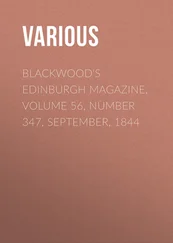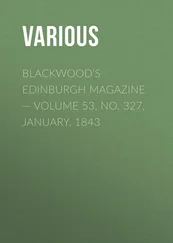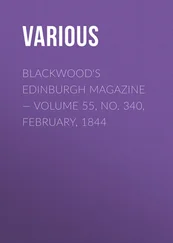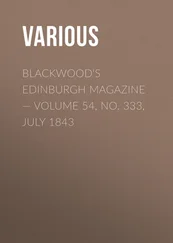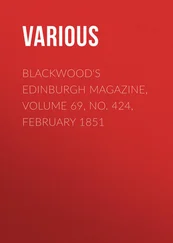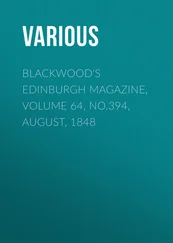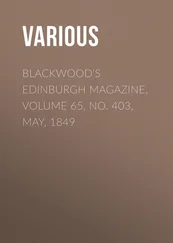Various - Blackwood's Edinburgh Magazine, Volume 58, No. 359, September 1845
Здесь есть возможность читать онлайн «Various - Blackwood's Edinburgh Magazine, Volume 58, No. 359, September 1845» — ознакомительный отрывок электронной книги совершенно бесплатно, а после прочтения отрывка купить полную версию. В некоторых случаях можно слушать аудио, скачать через торрент в формате fb2 и присутствует краткое содержание. Издательство: Иностранный паблик, Жанр: periodic, foreign_edu, Путешествия и география, на английском языке. Описание произведения, (предисловие) а так же отзывы посетителей доступны на портале библиотеки ЛибКат.
- Название:Blackwood's Edinburgh Magazine, Volume 58, No. 359, September 1845
- Автор:
- Издательство:Иностранный паблик
- Жанр:
- Год:неизвестен
- ISBN:нет данных
- Рейтинг книги:4 / 5. Голосов: 1
-
Избранное:Добавить в избранное
- Отзывы:
-
Ваша оценка:
- 80
- 1
- 2
- 3
- 4
- 5
Blackwood's Edinburgh Magazine, Volume 58, No. 359, September 1845: краткое содержание, описание и аннотация
Предлагаем к чтению аннотацию, описание, краткое содержание или предисловие (зависит от того, что написал сам автор книги «Blackwood's Edinburgh Magazine, Volume 58, No. 359, September 1845»). Если вы не нашли необходимую информацию о книге — напишите в комментариях, мы постараемся отыскать её.
Blackwood's Edinburgh Magazine, Volume 58, No. 359, September 1845 — читать онлайн ознакомительный отрывок
Ниже представлен текст книги, разбитый по страницам. Система сохранения места последней прочитанной страницы, позволяет с удобством читать онлайн бесплатно книгу «Blackwood's Edinburgh Magazine, Volume 58, No. 359, September 1845», без необходимости каждый раз заново искать на чём Вы остановились. Поставьте закладку, и сможете в любой момент перейти на страницу, на которой закончили чтение.
Интервал:
Закладка:
We are standing, for instance, on a broken foreground, across which the brier, the dog-rose, and the white bindweed have clasped themselves in fantastic tendrils. The white hemlock shoots up rankly by the hedge, and the tall bulrush and water-lily mark the course of the little stream which is sliding noiselessly past among the grass. It is early morning, as we see by the long oblique shadows. Yet industry is already at work. The wheel of that weather-stained and lichen-covered mill – call it Flatford if you will – is in motion, and the dripping water, glancing in the morning sun, descends from the cogs in a shower of diamonds. The stream that supplies the mill is crossed further down by a rustic bridge, as picturesque as it is inconvenient. Beyond, and towards the centre, a long wooded lane stretches out towards the horizon, close and overarching at top, but with the sunbeams straggling in between the trunks, and checkering the cool road with a network of light and shadow. About midway, a small spring, trickling from a bank, has been collected in a rude stone trough, for the refreshment of panting horse and wayworn traveller; beside which two market wains – the one on its way to the neighbouring town, the other returning from it – have stopped. The horses are watering; the waggoners gossiping over the news, or smoking together the calumet of peace; while a group of urchins, in whom the embryo ostler or future strapper are easily detected, are looking on with that interest in all that concerns horseflesh which distinguishes the rising members of an agricultural population. Beyond the lane are gentle hills, "rounded about by the low wavering sky" – some smoke indicating the market-town, and the spire of the village church leading the eye out of the picture, and crowning the cheerful serenity of the landscape.
The day advances, and the scene is changed. In the foreground we have a building-yard by the river. Boats and barges are seen in their rise, progress, decline, and fall; – some completed, some exhibiting merely their skeletons upon the stocks; some blistering in the sun beside the broken pier; some, which have seen better days, now entirely out of commission, and falling to pieces among the mud; – placed in all attitudes, and projecting broad and picturesque shadows along the ground. But these shadows are soft and transparent, not dark and cutting; for the sultry haze which rises steaming from all around, makes the summer sunshine veiled and dim. All nature is in a state of indolence. The lazy Stour sleeps beneath his fringes of elm and willow: a deep-laden barge comes leisurely along, as if anxious not to disturb his slumbers: the horse has plainly enough to do to make out his four miles an hour; and there is a dog on deck who seems nervous about hydrophobia. The man at the bow, depressing his head and elevating the lower part of his person to an American angle of elevation, has thrown his sturdy limbs across yon well-stuffed sacks of wheat, on their way to Flatford mill. Mercy on us! what can that fellow in the stern be about, pretending to steer? Just as we suspected – fast asleep, with his hand on the helm.
Another change – from the building-yard to the corn-field. The wind has risen as the day advanced, and driven off to the west the veil of vapour which had concealed the sun. The clouds ride high in heaven; and we see by their roll and motion that there is a refreshing air astir; – and there is need of it in this field of golden grain, framed, as it were, in the solid green of those groves, and over which the gray tower of Dedham church (which somehow or other finds its way into all these combinations of scenery) rises straight and motionless against the rounded forms of the ever-shifting sky. All here speaks of bustle and cheerful activity, peace and plenty. It is impossible to look at the scene, and think for a moment of the repeal of the corn-laws. Behind the stalwart band of reapers lie the heaps of sheaves that have already fallen beneath their sickle; the tall grain, swept by the wind, waves firm before them like a hostile rank yet unbroken; while the lord , as he is called in Suffolk, or leading man among the reapers and mowers, stands in advance of the rest, as if urging a final charge. In truth, there has been rather a lull among the workmen; for, breezy as the day is, still it is hot – the dinner-hour is nigh, and there is a visible anxiety evinced for the arrival of the commissariat. At last it is seen in the offing: the reapers, "sagacious of their quarry from afar," gather new vigour from the sight; and yonder tall fellow – an Irishman, we are positive even at this distance – seizing his sickle like one inspired, is actually working double tides.
But stay, we have got into wilder quarters, and here has been a storm. Ay, we thought the clouds, after such a sultry morning, were not rolling themselves into those ominous grey volumes for nothing. Broken ground lies before us in front, seemingly part of an old gravel-pit, down which winds a break-neck path, lost at yonder turning. Beneath us, a level flat, where the sullen verdure of the vegetation betrays the marshy, reedy, sterile character of the soil. Pools of water, here and there set amidst the swampy green, reflect the dark and watery clouds that are scudding above them. The lavender, the water-lily, the mallow, the fern, the fox-glove, luxuriate here; abundant food for botany, but not exactly in the place one would choose for botanizing – particularly, as is the case this moment, within an hour of sundown. Beyond the flat, the traces of a range of low hills, their outline at present lost in rain. Overhead, a spongy sky, darkening into a lurid gloom to the right; for there the laden thunder-clouds are about to discharge their freight; and right underneath, in the middle distance, an unhappy windmill, which has shortened sail during the preparatory blast, stands glimmering like a ghost through the gloom, obviously on the eve of the deluge. What may be the probable fate of the miller and his men in this conjuncture, humanity, of course, declines to contemplate; but, turning towards the left, sees the sun struggling through the opening eyelids of the clouds, the leaden hue of the sky on the right breaking off into a lustrous haze, and a rainbow growing into form and colour, which, as it spans the dripping landscape from east to west, gives token of a goodly day to-morrow.
These are but a few of the combinations which even this limited range of scenery evidently presented to the eye and fancy of a man like Constable; nor is it wonderful, after all, that to such materials, unpretending as they seem, an artist embued with a genuine love of nature should have succeeded in imparting a peculiar charm, and a never-ending freshness and variety. Amidst scenes of the sane tranquil cast did Hobbima and Waterlo find the subjects of those soothing pictures, the spell of which is acknowledged equally by the profound student of art and the simple admirer of nature. Scenes not materially different in their character did Ruysdael envelope in grandeur, depicting, as Constable expresses it in one of his lectures, "those solemn days peculiar to his country, and to ours, when, without storm, large rolling clouds scarcely permit a ray of sunlight to break the shades of the forest." And amidst the selfsame scenes – the same forest-lanes, and brooks, and woods, and waters – with the same happy accompaniments of rustic incidents, occupations, or amusements – did Constable's predecessor, Gainsborough, find his academy.
Very early in Constable's career, he adopted the principle which regulated through life the character of his painting. "There is room enough," he writes, after considering the Exhibition of 1802 – " There is room enough for a natural painter . The great vice of the present day is bravura – an attempt to do something beyond the truth. Fashion always had, and always will have, its day; but truth in all things only will last, and can only have just claims on posterity." Here, indeed, he felt, and justly, that there was an opening for him in the school of English landscape. Gainsborough, who had first communicated truth and life to the treatment of the genuine scenery of England, was no more. It is true, the grosser absurdities of the Smiths of Chichester, and the other compounders of landscapes secundum artem , with which we are familiar in the engravings of Woollet, in whose performances a kind of pictorial millennium appears to be realized; where the English cottage stands side by side with the Italian villa, and Norfolk bumpkins are seen making love to Arcadian shepherdesses knitting beneath the pillars of a Doric temple – these noxious grafts of a conventional taste upon the healthy stem of our native landscape-painting had disappeared. But still, the influence of this conventional taste in a great measure remained – shown in the established belief that subject made the picture, and necessitating, as was supposed, the exclusive adoption of certain established modes of composition, colouring, and treatment, from which the hardy experimentalist who should first attempt to deviate was sure, for a time at least, to encounter opposition; or, what was more probable, entire neglect.
Читать дальшеИнтервал:
Закладка:
Похожие книги на «Blackwood's Edinburgh Magazine, Volume 58, No. 359, September 1845»
Представляем Вашему вниманию похожие книги на «Blackwood's Edinburgh Magazine, Volume 58, No. 359, September 1845» списком для выбора. Мы отобрали схожую по названию и смыслу литературу в надежде предоставить читателям больше вариантов отыскать новые, интересные, ещё непрочитанные произведения.
Обсуждение, отзывы о книге «Blackwood's Edinburgh Magazine, Volume 58, No. 359, September 1845» и просто собственные мнения читателей. Оставьте ваши комментарии, напишите, что Вы думаете о произведении, его смысле или главных героях. Укажите что конкретно понравилось, а что нет, и почему Вы так считаете.

